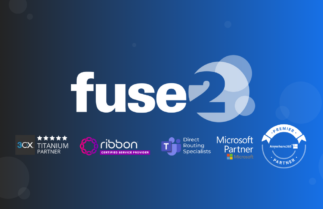Curious about switching to VoIP from your landline?
This blog post outlines the basics of VoIP, its functionality, and guides you on finding the optimal VoIP provider.
VoIP is at the forefront of communication technology being the prime choice for many small, medium-sized and large corporations seeking enhanced communication efficiency.
Highlights

What is VoIP or Voice over IP?
VoIP, or Voice over Internet Protocol, is a new cutting-edge communication technology that allows you to use phone calls through your broadband connection rather than a traditional landline. Functioning as an open standard for establishing calls over the Internet, some may also know it as Voice over IP.
A typical configuration of VoIP would be a router for internet connectivity that is then paired with a handset. This handset or business phone system utilises the internet to transmit your voice, similar to a conventional landline. The key distinction lies in the technology itself, which relies on the internet rather than traditional phone line infrastructure.
Phone service providers embrace VoIP to deliver telephone services to customers, eliminating the need for installing and maintaining physical phone lines and equipment. VoIP not only facilitates high-quality calls but also introduces advanced features typically unavailable with traditional landline services.
How does VoIP work?
VoIP transforms your voice into a digital format, compresses it, and then transmits it over the internet. The initiation and setup of the call are facilitated by the VoIP service provider, similar to your internet service provider.
Telephone conversations use small data packets to exchange information, and the internet can transmit these packets globally in less than a second making it more efficient than a telephone system.
Voice over Internet Protocol eliminates the need for traditional telephones in businesses altogether. As long as you have a broadband internet connection, such as DSL, cable, or fiber, VoIP can be seamlessly integrated within your business.
Example of how VoIP Works
- Your VoIP-enabled device, such as an IP phone or softphone, connects to your Local Area Network (LAN) through a switch or router.
- When you dial a telephone number, your IP phone sends a request to your VoIP service provider, indicating the desire to establish a call with the specified number.
- Fuse 2 as your VoIP service provider processes your request and establishes a connection with the intended party. This involves the initiation of a session and the allocation of resources for the call.
- Once the call is set up, data packets containing voice information are exchanged between your IP phone and the VoIP service provider. These packets carry the audio signals of your conversation.
- Your VoIP phone converts the received digital signals back into analog sound signals that can be heard. This transformation ensures that the recipient hears a natural, recognizable voice.
- The call is now in progress, allowing for two-way communication between the VoIP-enabled devices, and the conversation continues until one party ends the call.
- When you or the other party ends the call, the VoIP service provider concludes the session, freeing up resources and ending the data exchange between the devices.
How to make a call with VoIP?
To make a VoIP call, you’ll first require a VoIP business phone service, like Fuse2, and a robust internet connection with ample bandwidth, typically facilitated through high-speed broadband.
Afterward, you can make VoIP calls using any of the following devices:
Existing Phone Handset
Connect your current phone to the VoIP system using an ATA (analog telephone adapter), providing it with an IP address. Simply plug your phone into the ATA instead of directly into the wall socket.
Special IP Phone
Resembling a traditional analog phone, an IP phone features a handset with buttons, but instead of an RJ-11 phone connector, it has an RJ-45 connector. Plug it into an ethernet port on your router. Some VoIP companies might offer a complimentary IP phone depending on the season.
Computer
Utilise a VoIP app, often termed a ‘softphone,’ to make calls over VoIP. Ensure your computer has a sound card, and use either a headset or a microphone and speakers. Connect to the internet via ethernet or WiFi. Most reputable VoIP companies offer apps for both Windows and Mac.
Mobile Phone
Install the appropriate app and connect to WiFi for VoIP calls on your mobile phone. Alternatively, use a mobile data plan with 4G or higher speeds. VoIP apps generally support both Android and Apple iPhone (iOS) devices.
VoIP vs Landlines?
VoIP technology facilitates superior voice calls over the Internet, in contrast to landline phones that depend on a copper telephone network for both outgoing and incoming calls.
Deploying VoIP is streamlined through cloud management, eliminating the necessity for on-site installation or maintenance. Adding or modifying users becomes a software adjustment rather than requiring the intervention of an engineer.
Businesses opt for VoIP due to its enhanced calling quality and extensive feature set, all achieved without the complexities and costs associated with establishing an on-premises private branch exchange (PBX).
We would highly recommending switching to VoIP if:
- Our nation is phasing out landline phones.
- You’re experiencing subpar sound quality.
- You require advanced features.
- The contract for your on-site PBX is reaching its expiration.
- Transitioning to remote or hybrid work is on the horizon.
- Excessive costs for external calls are a concern.
- High expenses for long-distance international calls are an issue.

Advantages of VoIP
Embracing VoIP technology opens doors to a host of benefits, ranging from substantial cost savings to superior call quality and an array of advanced features
Reduce Costs
Drastically cuts call expenses for internal and internet calls, potentially saving up to 50%. This also extends to on-site maintenance and repair costs.
Enhanced Call Quality
Capitalise on your internet connectivity for high-definition call quality, with integrated management tools identifying and addressing potential network issues.
More Functionality
Provides premium features like auto attendants, call recording, and call queues without necessitating the installation of costly add-ons.
Affordable International Calling
International long-distance rates are remarkably low, such as $0.04 per minute for calls to Mexico and $0.01 for calls to the United Kingdom.
Rapid Deployment
Requires only an internet connection and a softphone or handset for swift setup.
Remote Accessibility
Seamlessly use your phone service from any location. No intricate technical setup is required for remote work.
Cost-Effective VoIP Desk Phones
Obtain VoIP desk phones at a reasonable cost, with some providers offering them for free. Many come with a mobile app usable on desktops or mobile devices, providing an alternative to traditional handsets.
Streamlined Operations
Accelerates communication processes and collaboration through features like instant messaging, video conferencing, and file sharing.
Enhanced Security Measures
Implements robust security protocols to safeguard communication channels and data, ensuring a secure environment for business communication.
Scalability
Easily scales to accommodate the growing needs of businesses, making it suitable for both small enterprises and large corporations.
Flexible Plans
Offers adaptable pricing plans, allowing businesses to choose options that align with their specific requirements and budget constraints.
Effortless Integration
Seamlessly integrates with other business tools and applications, enhancing overall efficiency and productivity.
Reliable Customer Support
Access to dedicated customer support services to address queries, troubleshoot issues, and ensure uninterrupted communication services.
Disadvantages of VoIP
The primary drawback of opting for VoIP over a traditional phone system lies in the dependency on your internet connection for call quality. It is really important to assess and analyse your internet connection thoroughly before transitioning to VoIP.
A high-speed broadband connection generally suffices, but it is advisable to conduct a comprehensive check. The most effective method to gauge network speed and stability is through a VoIP quality test—an accurate measure of your network’s capacity and anticipated call quality. This test meticulously examines potential issues such as latency, bandwidth, SIP ALG problems, packet loss, and jitter, all of which could adversely affect voice quality. Early detection and troubleshooting of any network issues during the initial stages of VoIP setup are crucial. You can test your internet speed with Ookla.
Disadvantages for VoIP phone systems
- Bandwidth
- SIP ALG issues
- Packet Loss
- Jitter
Upon careful consideration of the pros and cons, VoIP emerges as a clear winner. As long as your internet connection remains stable, embracing VoIP not only ensures cost savings but also introduces a plethora of new and advantageous features.

Best VoIP phone system features?
Discover the compelling features offered by a cloud-based business phone system. Delve into the most sought-after VoIP features that businesses can leverage and enjoy.
Automated receptionist
An auto attendant empowers you to customise the greeting options for callers dialling into your business.
Example
- Press option 1 for sales
- Press 2 for marketing
- Press 3 for technical assistance
This feature allows you to route calls to specific departments or individuals based on the nature of the query. With the ability to configure VoIP components through a web browser, changes can be made effortlessly without the need for site visits.
Utilise VoIP through Laptops & Mobile Phones
You don’t need a dedicated VoIP handset to use our VoIP service as most modern mobile and desktop apps facilitate the use of your VoIP phone service.
Ideal for individuals on the move, such as sales professionals, technicians, and remote workers frequenting diverse locations like coffee shops and co-working spaces.
Ensures accessibility for all company members, regardless of their location, country or preferred device as all they need is an internet connection. Some users may opt for headsets or mobile devices, reducing the reliance on physical handsets and potentially saving upfront costs.
HD Call Quality
Benefit from crystal-clear conversations through HD call quality, thanks to specialised codecs designed for superior audio.
Presents your business as reliable and committed to delivering a high-quality customer communication experience.
Hub for all business communications
You’re able to integrate multiple communication methods, including instant messaging, calls, and video conferencing, into one platform.
Offers advanced features such as call recording, reporting, and voicemail, representing a progression beyond standard VoIP.
Enhances internal collaboration and lays the foundation for future advancements, such as video calls and instant messaging.
Call Encryption
Addressing internet security concerns, VoIP ensures the encryption of data in transit and at rest.
Guarantees secure communication, with only metadata accessible. For example, call logs may display timestamp and duration but not the content of the conversation.
Call Recording
VoIP enables call recording for monitoring content quality or meeting regulatory requirements.
Basic call recording options store calls in a cloud-based portal for later download.
Advanced call recording features include sentiment analysis, allowing the identification of customer satisfaction levels or creating upselling opportunities.
Conference Calling
Conference calling is a feature that allows multiple participants to join a single phone call. It enables efficient collaboration and communication among team members or stakeholders, fostering real-time discussions, decision-making, and information sharing.
Voicemail to Email Transcriptions
Voicemail to email transcriptions is a feature that converts voice messages left in voicemail into text format and sends them to the designated email address. This functionality ensures that users can quickly and conveniently read their voicemail messages rather than listening to audio recordings. It enhances accessibility and allows for efficient message retrieval, enabling users to stay informed and respond promptly to important communications.
Scalability
VoIP scalability means that the solution can seamlessly grow as your needs increase, whether it’s in terms of the number of users, features, or overall capacity. A scalable system ensures flexibility and efficiency, allowing businesses to adjust and expand their communication infrastructure without significant disruptions or complications.
How much does VoIP Cost?
VoIP offers a surprisingly cost-effective solution when you consider its extensive capabilities, standing as a significant advantage over traditional phone lines.
In a nutshell, you can anticipate paying around £26 per user per month for VoIP, showcasing substantial savings in comparison to traditional phone systems or on-premises PBX setups.
Here’s a breakdown of typical VoIP costs versus traditional phone systems.
VoIP
- Initial costs: £0-£37 per line
- Monthly costs: £14-£33 per line
- Device costs: £65-£480 per IP phone
- International calls: £0.007+ per minute
- Taxes and fees: Varies based on your location.
Traditional Phone Systems
- Installation fees: £37-£74 per drop
- Deposit: £74-£370
- Maintenance contract: £740+ annually
- International calls: £0.74+ per minute
- Credit check: Soft or hard pull.
It’s essential to note that traditional phone systems often come with hidden costs that might catch you off guard. Therefore, we strongly recommend obtaining a free quote from us to accurately determine your specific VoIP pricing in GBP.

How to choose a VoIP Provider?
While many providers offer solid basics in VoIP, selecting the right provider that aligns with your specific needs is crucial.
For small businesses seeking a straightforward transition to VoIP without complex requirements, opt for a provider specialising in small business VoIP. Look for a provider that:
Implementation Experience
Offers comprehensive support for configuring advanced features like auto attendants and call queues.
Assists in deploying physical handsets, providing user training, and guiding on optional hardware or software needs.
Network Compatibility
Ensures compatibility with your existing network or offers customization to fit your specific network requirements.
Industry Experience
Has a track record of assisting companies similar to yours, with proven success stories in your industry.
Customer Support
Provides reliable customer service, especially for critical aspects like number porting, on-site setup, and ongoing support.
Offers round-the-clock or swift customer support to address issues promptly.
High Availability and Security
Demonstrates proven reliability with minimal downtime such as Fuse 2, which provides increased uptime with 24/7 monitoring.
Adheres to stringent security standards, meeting certifications like ISO/IEC 27001.
Still considering a switch to VoIP?
changes in the telecommunications landscape, particularly the gradual phase-out of traditional landline services in parts of the US and UK, make transitioning to VoIP a strategic necessity. The Federal Communications Commission (FCC) has officially announced the phasing out of traditional landline phone services, primarily driven by the costly maintenance associated with landlines. Consequently, VoIP solutions emerge as the inevitable and optimal choice for modern communication needs.
History of VoIP
In the 1970s, researchers delved into the potential of using internet protocols to connect phone systems, a time when dialing into bulletin board systems (BBS) for message exchange was prevalent.
During this era, the expense of long-distance phone calls spurred innovations in real-time digital voice networks, enabling live voice conversations over early data networks. The 1990s witnessed the emergence of the first commercial VoIP applications, facilitating voice calls directly from computers.
VoIP technology underwent continuous advancements in the 1990s and 2000s, introducing crucial features such as video conferencing and further standardizing the handling of calls within VoIP systems.
Today, VoIP has largely supplanted analog phone lines, transforming voice calls into digital transmissions over the internet rather than through traditional phone lines. The advantages of VoIP encompass lower costs, enhanced features, and increased flexibility compared to legacy landline systems. As a result, VoIP has become an integral component of modern business phone and communication systems.
What’s the future of VoIP with AI?
The learning capabilities inherent in AI signal a progressive evolution for VoIP systems, making them smarter and more efficient. AI in VoIP isn’t just a passing trend; it signifies a leap into a future where communication becomes increasingly interactive, responsive, and streamlined. As we venture into a future propelled by the boundless potential of AI, it’s evident that AI VoIP is reshaping the communication landscape, revolutionising each call.
The future of AI within VoIP holds immense promise, ushering in unprecedented improvements in communication. With businesses embracing this cutting-edge technology, the realm of possibilities is set to expand, propelling us toward a future where intelligent, seamless, and efficient communication becomes the standard.
How can i setup VoIP?
For a modest setup, all you require for initial setup is a subscription to your business VoIP provider and a device for making calls. This device could be a desk phone, a laptop with a softphone, or a VoIP app on your mobile phone.
Assuming you already possess a broadband connection and a router, no additional VoIP equipment is necessary.
For medium-sized businesses and larger corporations, managing VoIP may involve opting for a dedicated firewall or switch in addition to the router. In cases where there are existing analog phones or other devices to be retained, the use of an analog telephone adapter (ATA) becomes essential. These compact adapters bridge your VoIP solution with traditional telephone services and devices, accommodating items such as old fax machines and alarm systems. The needs for VoIP setup expand with the scale of the enterprise.
How to switch to VoIP
Easy, we take care of everything ensuring a seamless transition from your traditional phones lines or another VoIP provider to Fuse 2. Customers appreciate us for our effortless onboarding process. We’ve meticulously curated a selection of top-notch phones and hardware, simplifying the setup. All our phones come pre-configured, requiring just a straightforward plug-in.
There’s no need to deal with IP addresses or firmware adjustments to link phones to your VoIP account. Instead, you can easily assign phones to your staff through a user-friendly online interface.
VoIP FAQs
What is the difference between VoIP and phone call?
The primary distinction lies in the communication medium: VoIP utilises the internet for calls, whereas landlines rely on copper wires. Consequently, VoIP calls are unrestricted by geographical limitations and can be made wherever there’s an internet connection. Additionally, the efficiency of fiber-optic cables surpasses that of traditional copper wires used in landlines.
Are VoIP phone calls free?
Upon registration, individuals can enjoy free VoIP calls to others within the same service. For VoIP calls to standard landline and mobile numbers, there might be a monthly subscription fee or a per-minute charge. Nevertheless, these calls typically come at a considerably lower cost compared to traditional landline-to-landline or mobile-to-mobile phone calls.
What 2 devices do I need for VoIP?
Transitioning to VoIP is a straightforward procedure. The setup is uncomplicated, and there’s no need for intricate equipment. All that’s necessary is an internet connection facilitated by your modem and router, along with an adapter capable of managing VoIP and a VoIP compatible phone
Can you just plug a VoIP phone into a router?
Numerous home routers permit a straightforward connection by plugging in a VoIP phone, while a few may require configuration to ensure compatibility with a VoIP phone.
Are all cordless phones compatible with VoIP?
Not all hardware is VoIP compatible, most modern hardware is however, older models and versions may not be. Distributors we recommend are Yealink or Fanvill






